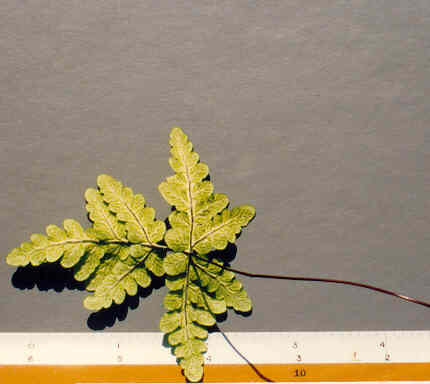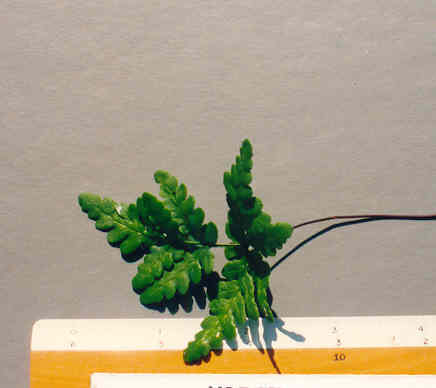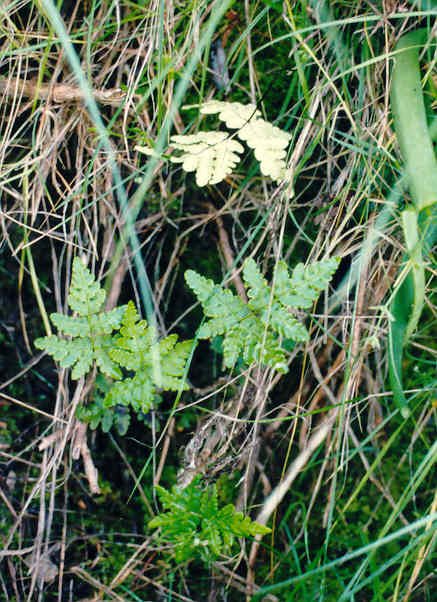
Pentagramma triangularis (Kaulf.) Yatsk.,Windh., & Wollenw.
ssp. triangularis
= Pityogramma triangularis var. triangularis
 |
Pentagramma triangularis (Kaulf.) Yatsk.,Windh., & Wollenw.ssp. triangularis= Pityogramma triangularis var. triangularis
Pteridaceae (Brake Family)NativeGoldenback Fern |
March Photo
Plant Characteristics:
Perennial, the rhizome stout, with brownish or blackish scales 2-2.5 mm.
long; fronds many, 1-4 dm. high, the stipes red-brown when young, darker in age,
twice as long as the blades, these deltoid-pentagonal, 6-18 cm. long, almost as
broad, pinnate or the basal pinnae again pinnate; pinnules oblong, lobed to
subentire, yellow-powdery beneath, glabrous above; sori +/- covering the backs
of the pinnules.
Habitat:
Common in +/- rocky shaded places below 5000 ft.; many Plant Communities;
most of cismontane Calif.; from n. L. Calif. to B.C.
Name:
Greek, pityron, bran, and gramme, line, because of the
sori. (Munz, Flora So. Calif.
31). Latin, tri, three and
Latin, angulus, angle. (Jaeger
270, 19). Triangularis, referring to the triangular frond
blades. (my comment).
General: Uncommon, found on
the bluffs above Back Bay Drive northerly of the Eastbluff burn area and
photographed there. A few weeks
later I found the plant again, higher on the bluff, and a little farther
northerly. I had looked
unsuccessfully for this species for a number of years and it was not until 1995
that I finally found it. (my comments).
As late as the 19th century, ferns and other
non-flowering plants were called “cryptogams” because their reproduction was
hidden. There was lack of understanding about the nature of the “dust”
or fernseed that fell from the underside of the leaves; was it a seed or pollen?
Today we know that fernseed is a spore, not a seed as it contains no embryo.
(see Polypodium californicum for more on spore germination) In
Shakespeare’s time, fernseed was believed to have magical properties and it
could be used to locate treasure or conserve wealth. Fernseed could only
be collected on the bottommost of a tall stack of pewter plates at midnight of
Midsummer’s Eve—provided the goblins and fairies, who were free to roam the
woods only on that night, did not snatch if first. It was even thought
that if you placed fernseed among money, it would never decrease, no matter how
much was spent. (Machol, Guenther K. “FROM SPORE TO SPORLING: THE
BIRTH OF A FERN” FREMONTIA, A Journal of the California Native Plant
Society Vol. 32, No. 2 April 2004 pp. 10-15).
A rather small genus, largely from trop. America.
(Munz, Flora So. Calif. 31).
A puzzling complex of intergrading chemical, chromosomal, and
morphological variants; for these we prefer the rank of var. but have used ssp.
here because combinations of that rank already exist.
(Hickman, Ed. 108).
Text Ref:
Abrams, Vol. I 20; Munz, Flora So. Calif. 32; Hickman, Ed. 108;
Roberts 4.
Photo Ref:
Mar 95 # 11,13,14,24A.
Identity: by R. De Ruff, confirmed by John Johnson.
First Found: March 1995.
Computer Ref: Plant Data 473.
Have plant specimen
Last Edit 4/12/05.
 |
 |
March Photo March Photo